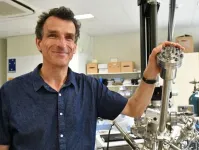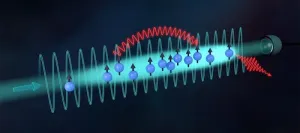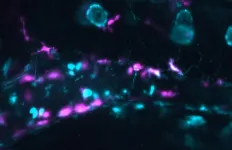(Press-News.org) A new material for high density data storage can be erased and recycled in a more efficient and sustainable way, providing a potential alternative to hard disk drives, solid-state drives and flash memory in future.
The low-cost polymer stores data as ‘dents’, making a miniscule code in patterns, with the indents just nanometers in size – promising to store more data than typical hard disk drives.
The new Flinders University Chalker Lab polymer, which can have the information in it wiped in seconds by short bursts of heat and be reused several times, is described in a major new article in the prestigious international journal Advanced Science.
“This research unlocks the potential for using simple, renewable polysulfides in probe-based mechanical data storage, offering a potential lower-energy, higher density and more sustainable alternative to current technologies,” says first author and PhD candidate Abigail Mann, from the College of Science and Engineering at Flinders University.
Made from low-cost materials, sulfur and dicyclopentadiene, the researchers used an atomic force microscope and a scanning probe instrument to make and read the indentations.
Senior author Professor Justin Chalker says the development is the latest example of new era polymers capable of making a difference to a wide range of industries.
“The age of big data and artificial intelligence is increasingly driving demand for data storage solutions,” says Professor Chalker.
“New solutions are needed for the ever-growing computing and data storage needs of the information era.
“Alternatives are being sought to hard disk drives, solid-state drives and flash memory which are constrained by data density limits – or the amount of information they can store in a particular area or volume.”
Using the method, the polymer chemistry team at Flinders University demonstrated data storage densities that exceed typical hard disk drives.
The polymer chemistry method allowed for the data writing, reading and erasing to be repeated many times, which is important in computing and data storage.
The concept of storing data as indents on the surface of materials has been explored previously by computing giants such as IBM, LG Electronics and Intel. While this mechanical data storage strategy provided some very promising demonstrations and innovations in storage, the energy requirements, costs, and complexities of the data storage materials are some of the barriers to commercialising the technology.
Senior researchers Dr Pankaj Sharma and Dr Christopher Gibson say the Flinders polymer addresses these challenges with its unique physical structure that allows mechanical force to encode the data via an indentation, and a chemical structure that allows rapid reorganisation of the polymer upon heating to erase that indent.
“The low cost of the building blocks (sulfur and dicyclopentadiene) are an attractive feature that can support future development of the polymer in data storage applications,” adds Chalker Lab PhD candidate Samuel Tonkin.
The article, ‘Probe-Based Mechanical Data Storage on Polymers Made by Inverse Vulcanization’ (2024) by Abigail K Mann, Samuel J Tonkin, Pankaj Sharma, Christopher T Gibson and Justin M Chalker has been published in Advanced Science (Wiley). DOI: 10.1002/advs.202409438
Acknowledgements: The project was directed and supervised by Dr Pankaj Sharma, Dr Christopher Gibson and Professor Justin Chalker. Financial support for this research was provided by the Australian Research Council (DP200100090, DP230100587, and FT220100054). Key technical support and instrumentation essential for this research was provided by Flinders Microscopy and Microanalysis (FMMA), Adelaide Microscopy, and the Australian National Fabrication Facility (ANFF).
END
New polymer ramps up quest for better data storage
2024-12-18
ELSE PRESS RELEASES FROM THIS DATE:
Step forward in generating solar-powered hydrogen
2024-12-18
Another advance has been made by experts in nano-scale chemistry to propel further development of sustainable and efficient generation of hydrogen from water using solar power.
In a new international collaborative study – led by Flinders University with collaborators in South Australia, the US and Germany – experts have identified a novel solar cell process to potentially use in future technologies for photocatalytic water splitting in green hydrogen production.
Combined with a catalyst – developed by US research led by Professor Paul Maggard – for water splitting, the study found the new class of kinetically stable ...
Research shows solitude is better for your health when it’s not too intense
2024-12-18
CORVALLIS, Ore. – Hiking by yourself deep in a forest and similar episodes of intense solitude are not as likely to restore energy and enhance social connectedness as less complete forms of solitude, such as reading in a café or listening to Spotify while commuting, research by Oregon State University suggests.
The findings are important because of solitude’s role in building connectedness, a key factor in a person’s overall health picture. According to the U.S. Centers for Disease Control and Prevention, strong social ties are linked with a longer lifespan, better mental health and a lower risk of serious illness, including heart ...
Wildfire surges in East, Southeast US fueled by new trees and shrubs
2024-12-18
AGU press contact:
Liza Lester, +1 (202) 777-7494, news@agu.org (UTC-5 hours)
Researcher contact:
Victoria Donovan, University of Florida, victoria.donovan@ufl.edu (UTC-5 hours)
WASHINGTON — The eastern U.S. has more trees and shrubs than three decades ago. This growth, driven by processes such as tree and understory infilling in unmanaged forests, is helping fuel wildfires, contributing to changing fire regimes in the eastern half of the country, according to a new study.
Some parts of the eastern and southeastern United States have experienced a tenfold increase ...
No cavity, no party: Free-space atoms give superradiant transition a pass
2024-12-18
Isolated atoms in free space radiate energy at their own individual pace. However, atoms in an optical cavity interact with the photons bouncing back and forth from the cavity mirrors, and by doing so, they coordinate their photon emission and radiate collectively, all in sync. This enhanced light emission before all the atoms reach the ground state is known as superradiance. Interestingly, if an external laser is used to excite the atoms inside the cavity moderately, the absorption of light by the atoms and the collective emission can ...
Women often told that severity of medical abortion pain no worse than period cramps
2024-12-18
Women opting for a medical abortion at home are often advised that the procedure is likely to be no more painful than period cramps, suggest the results of a survey, carried out by the British Pregnancy Advisory Service (BPAS), and published online in the journal BMJ Sexual & Reproductive Health.
This leaves many women unprepared for the intensity of the pain they experience, with some survey respondents saying they would have chosen a different option, had they known.
More realistic and patient centred information needs to be provided to enable women to make ...
Air pollution linked to increased hospital admissions for mental/physical illness
2024-12-18
Cumulative exposure to air pollution over several years is linked to a heightened risk of admission to hospital for mental/behavioural and physical illness, finds Scottish research published in the open access journal BMJ Open.
Stricter environmental restrictions are needed to curb the impact on secondary care, conclude the researchers.
Previously published research on the health effects of long term exposure to ambient air pollution has tended to emphasise deaths rather than hospital admissions, and physical, rather than mental, ill ...
Using drones, UH researchers assess the health of humpback whale mother-calf pairs across the Pacific Ocean
2024-12-17
In a groundbreaking study published this week in The Journal of Physiology, biologists at the Marine Mammal Research Program (MMRP) at the University of Hawaiʻi at Manoa Hawaiʻi Institute of Marine Biology (HIMB) used drone imagery to advance understanding of how lactating humpback whales and their calves fare as they traverse the Pacific Ocean. Recent declines in North Pacific humpback whale reproduction and survival of calves highlight an urgent need to understand how mother-calf pairs expend energy across their migratory ...
Allen Institute names Julie Harris, Ph.D., as new Vice President of The Paul G. Allen Frontiers Group
2024-12-17
SEATTLE, WASH.—December 17, 2024—The Allen Institute today announced the appointment of Julie Harris as the new Vice President of The Paul G. Allen Frontiers Group. Harris was previously Executive Vice President of Research Management at the Cure Alzheimer’s Fund where she oversaw the funding strategy and research priorities for a ~$29 million grant portfolio in support of the most promising science and scientists working to end the burden of Alzheimer’s disease.
Between 2011 and 2020 Harris worked at the Allen Institute for Brain Science as ...
Bad bacteria can trigger painful gut contractions; new research shows how
2024-12-17
Downloadable assets for media use:
https://uoregon.canto.com/b/MSHJ8
EUGENE, Ore. — Dec. 18, 2024 — After a meal of questionable seafood or a few sips of contaminated water, bad bacteria can send your digestive tract into overdrive. Your intestines spasm and contract, efficiently expelling everything in the gut — poop and bacteria alike.
A new study from the University of Oregon shows how one kind of bacteria, Vibrio cholerae, triggers those painful contractions by activating the immune system. The research also finds a more general explanation for how the gut rids itself of unwanted intruders, which could also help scientists ...
Partnership advances targeted therapies for blood cancers
2024-12-17
Huntsman Cancer Institute at the University of Utah (the U) has joined other institutions in an innovative clinical trials program designed to match patients with acute myeloid leukemia (AML) and myelodysplastic syndromes (MDS) with a clinical trial specifically designed for the genetic signature of their disease. Sponsored by the National Cancer Institute (NCI), the myeloMATCH program aims to improve precision medicine, the use of therapies ...








